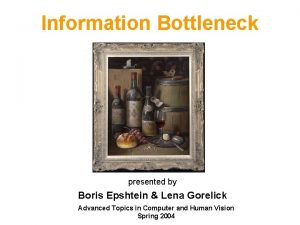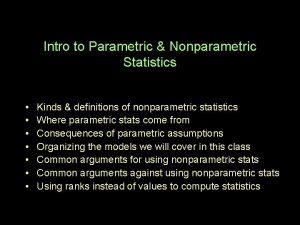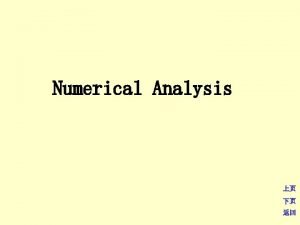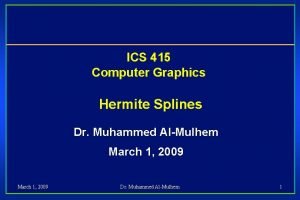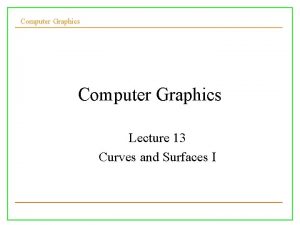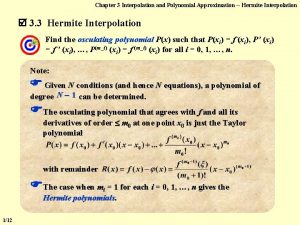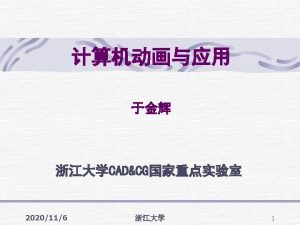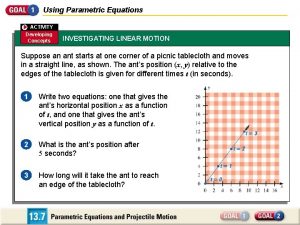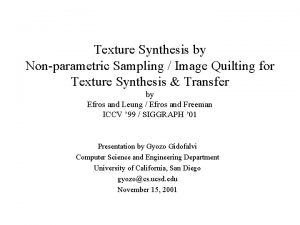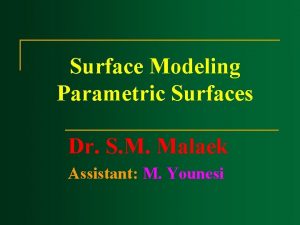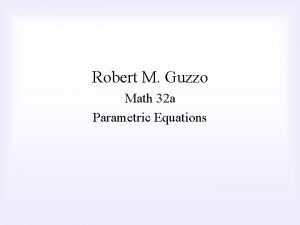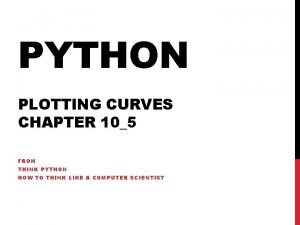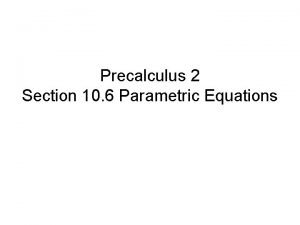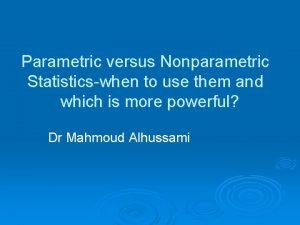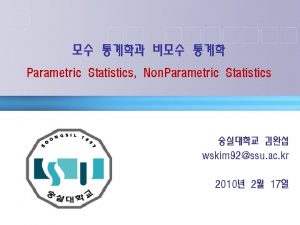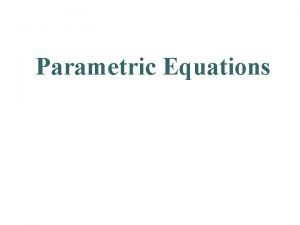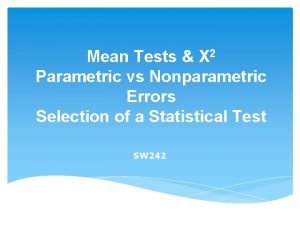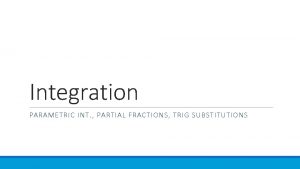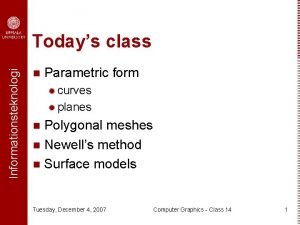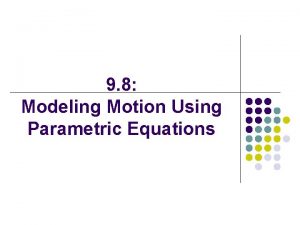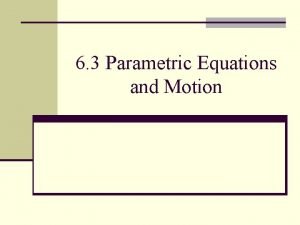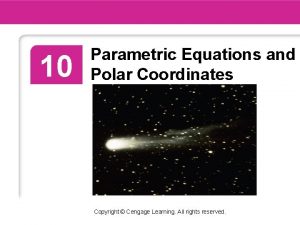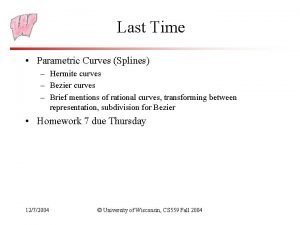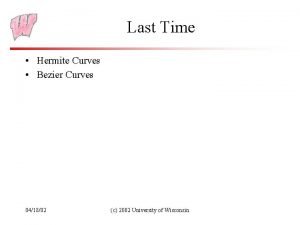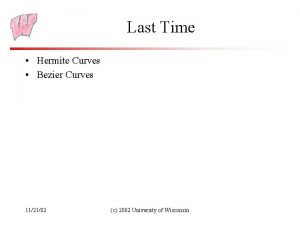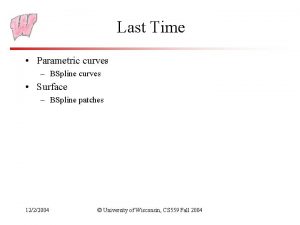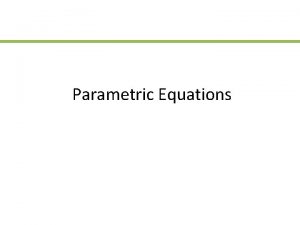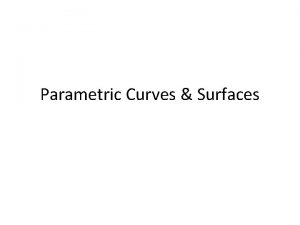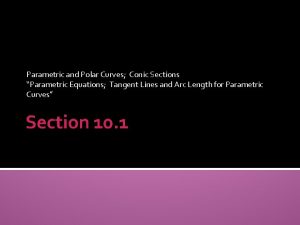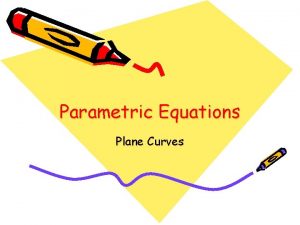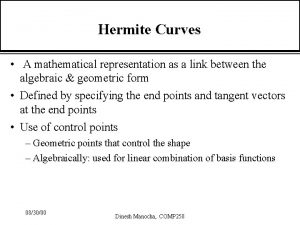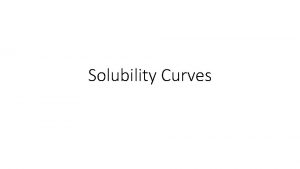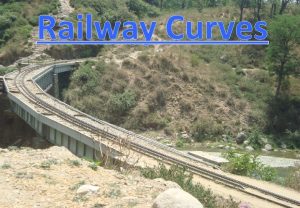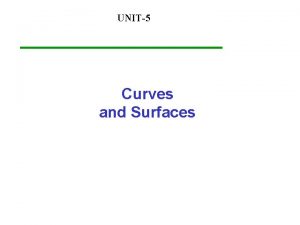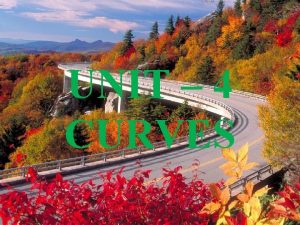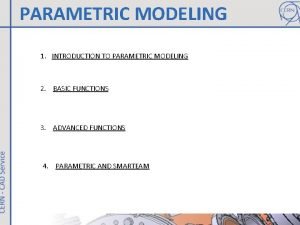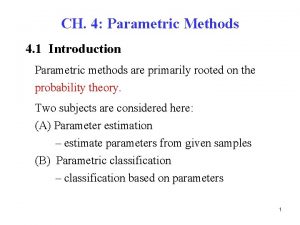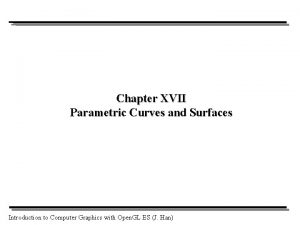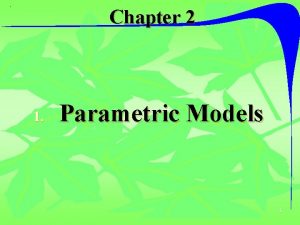Last Time Introduction to parametric curves Hermite curves
























- Slides: 24

Last Time • • Introduction to parametric curves Hermite curves Bezier curves Continuity 4/27/04 © University of Wisconsin, CS 559 Spring 2004

Today • Geometric continuity • Parametric surfaces – General Tensor product surfaces – Bezier surfaces • BSplines • Homework 7 available, due Thursday May 6 in class 4/27/04 © University of Wisconsin, CS 559 Spring 2004

Continuity • When two curves are joined, we typically want some degree of continuity across the boundary (the knot) – C 0, “C-zero”, point-wise continuous, curves share the same point where they join – C 1, “C-one”, continuous derivatives, curves share the same parametric derivatives where they join – C 2, “C-two”, continuous second derivatives, curves share the same parametric second derivatives where they join – Higher orders possible 4/27/04 © University of Wisconsin, CS 559 Spring 2004

Bezier Continuity P 0, 1 P 0, 2 P 0, 0 P 1, 3 J P 1, 1 P 1, 2 Disclaimer: Power. Point curves are not Bezier curves, they are interpolating piecewise quadratic curves! This diagram is an approximation. 4/27/04 © University of Wisconsin, CS 559 Spring 2004

Sketch of Proof for C 1 Bezier curve equation: Parametric derivative: Evaluated at endpoint of curve (note proves tangent property): 4/27/04 © University of Wisconsin, CS 559 Spring 2004

Proof (cont) P 0, 1 P 0, 0 P 0, 2 P 1, 3 J P 1, 1 P 1, 2 C 1 requires equal parametric derivatives: 4/27/04 © University of Wisconsin, CS 559 Spring 2004

DOF and Locality • The number of degrees of freedom (DOF) can be thought of as the number of things a user gets to specify – If we have n piecewise Bezier curves joined with C 0 continuity, how many DOF does the user have? – If we have n piecewise Bezier curves joined with C 1 continuity, how many DOF does the user have? • Locality refers to the number of curve segments affected by a change in a control point – Local change affects fewer segments – How many segments of a piecewise cubic Bezier curve are affected by each control point if the curve has C 1 continuity? – What about C 2? 4/27/04 © University of Wisconsin, CS 559 Spring 2004

Geometric Continuity • Derivative continuity is important for animation – If an object moves along the curve with constant parametric speed, there should be no sudden jump at the knots • For other applications, tangent continuity might be enough – – Requires that the tangents point in the same direction Referred to as G 1 geometric continuity Curves could be made C 1 with a re-parameterization: u=f(t) The geometric version of C 2 is G 2, based on curves having the same radius of curvature across the knot • What is the tangent continuity constraint for a Bezier curve? 4/27/04 © University of Wisconsin, CS 559 Spring 2004

Bezier Geometric Continuity P 0, 1 P 0, 2 P 0, 0 P 1, 3 J P 1, 1 P 1, 2 for some k 4/27/04 © University of Wisconsin, CS 559 Spring 2004

Parametric Surfaces • Define points on the surface in terms of two parameters x(s, 1) s • Simplest case: bilinear interpolation P 0, 1 P 1, 1 x(s, t) t P 0, 0 s 4/27/04 x(s, 0) © University of Wisconsin, CS 559 Spring 2004 P 1, 0

Tensor Product Surface Patches • Defined over a rectangular domain – Valid parameter values come from within a rectangular region in parameter space: 0 s<1, 0 t<1 • Use a rectangular grid of control points to specify the surface – 4 points in the bi-linear case on the previous slide, more in other cases • Surface takes the form: – For some functions Fi, s and Fj, t 4/27/04 © University of Wisconsin, CS 559 Spring 2004

Bezier Patches • As with Bezier curves, Bin(s) and Bjm(t) are the Bernstein polynomials of degree n and m respectively • Most frequently, use n=m=3: cubic Bezier patch – Need 4 x 4=16 control points, Pi, j 4/27/04 © University of Wisconsin, CS 559 Spring 2004

Bezier Patches (2) • Edge curves are Bezier curves • Any curve of constant s or t is a Bezier curve • One way to think about it: – Each row of 4 control points defines a Bezier curve in s – Evaluating each of these curves at the same s provides 4 virtual control points – The virtual control points define a Bezier curve in t – Evaluating this curve at t gives the point x(s, t) 4/27/04 © University of Wisconsin, CS 559 Spring 2004

Properties of Bezier Patches • Which vertices, if any, does the patch interpolate? Why? • What can you say about the tangent plane at each corner? Why? • Does the patch lie within the convex hull of its control vertices? 4/27/04 © University of Wisconsin, CS 559 Spring 2004

Properties of Bezier Patches • The patch interpolates its corner points – Comes from the interpolation property of the underlying curves • The tangent plane at each corner interpolates the corner vertex and the two neighboring edge vertices – The tangent plane is the plane that is perpendicular to the normal vector at a point – The tangent plane property derives from the curve tangent properties and the way to compute normal vectors • The patch lies within the convex hull of its control vertices – The basis functions sum to one and are positive everywhere 4/27/04 © University of Wisconsin, CS 559 Spring 2004

Bezier Patch Matrix Form • Note that the 3 matrices stay the same if the control points do not change – The middle product can be pre-computed, leaving only: 4/27/04 © University of Wisconsin, CS 559 Spring 2004

Bezier Patch Meshes • A patch mesh is just many patches joined together along their edges – Patches meet along complete edges – Each patch must be a quadrilateral OK OK 4/27/04 Not OK © University of Wisconsin, CS 559 Spring 2004 Not OK

Bezier Mesh Continuity • Just like curves, the control points must satisfy constraints to ensure parametric continuity – How do we ensure C 0 continuity along an edge? – How do we ensure C 1 continuity along an edge? – How do we ensure C 2 continuity along an edge? • For geometric continuity, constraints are less rigid • What can you say about the vertices around a corner if there must be C 1 continuity at the corner point? 4/27/04 © University of Wisconsin, CS 559 Spring 2004

Bezier Mesh Continuity • Just like curves, the control points must satisfy rigid constraints to ensure parametric continuity – C 0 continuity along an edge? Share control points at the edge – C 1 continuity along an edge? Control points across edge are collinear and equally spaced – C 2 continuity along an edge? Constraints extent to points farther from the edge • For geometric continuity, constraints are less rigid – Still collinear for G 1, but can be anywhere along the line • What can you say about the vertices around a corner if there must be C 1 continuity at the corner point? – They are co-planar (not the interior points, just corner and edge) 4/27/04 © University of Wisconsin, CS 559 Spring 2004

Rendering Bezier Patches • Option 1: Evaluate at fixed set of parameter values and join up with triangles – – Can’t use quadrilaterals because points may not be co-planar Ideal situation for triangle strips Advantage: Simple, and Open. GL has commands to do it for you Disadvantage: No easy way to control quality of appearance • Option 2: Subdivision – Allows control of error in the triangle approximation – Extend 1 D curve subdivision to do surfaces – Similar to other subdivision schemes we’ve seen 4/27/04 © University of Wisconsin, CS 559 Spring 2004

Midpoint Subdivision • Repeatedly join midpoints to find new control vertices – Do it first for each row of original control points: 4 x 4 -> 4 x 7 – Then do it for each column of new control points: 4 x 7 -> 7 x 7 4/27/04 © University of Wisconsin, CS 559 Spring 2004

A Potential Problem • One (good) way to subdivide, is: – If a control mesh is flat enough – draw it – Else, subdivide into 4 sub-patches and recurse on each • Problem: Neighboring patches may not be subdivided to the same level – Cracks can appear because join edges have different control meshes – This can be fixed by adding extra edges Crack 4/27/04 © University of Wisconsin, CS 559 Spring 2004

Computing Normal Vectors • The partial derivative in the s direction is one tangent vector • The partial derivative in the t direction is another • Take their cross product, and normalize, to get the surface normal vector 4/27/04 © University of Wisconsin, CS 559 Spring 2004

Bezier Curve/Surface Problems • To make a long continuous curve with Bezier segments requires using many segments – Same for large surface • Maintaining continuity requires constraints on the control point positions – The user cannot arbitrarily move control vertices and automatically maintain continuity – The constraints must be explicitly maintained – It is not intuitive to have control points that are not free 4/27/04 © University of Wisconsin, CS 559 Spring 2004
 Bmk+
Bmk+ Parametric and non parametric test
Parametric and non parametric test Parametric and non parametric algorithms
Parametric and non parametric algorithms Parametric
Parametric Cubic hermite interpolation
Cubic hermite interpolation Hermite curve in computer graphics
Hermite curve in computer graphics What are curves in computer graphics
What are curves in computer graphics Cubic hermite interpolation
Cubic hermite interpolation Hermite曲线
Hermite曲线 Parametric equations activity
Parametric equations activity Texture synthesis by non-parametric sampling
Texture synthesis by non-parametric sampling Surface modelling in cad
Surface modelling in cad Parametric equations word problems
Parametric equations word problems Matplotlib parametric plot
Matplotlib parametric plot Parametic equations
Parametic equations Cramers v interpretation
Cramers v interpretation Parametric statistics
Parametric statistics Parametric insurance nat cat
Parametric insurance nat cat Cartesian equations
Cartesian equations Parametric vs nonparametric test
Parametric vs nonparametric test Parametric integration
Parametric integration Equation of ellipse in parametric form
Equation of ellipse in parametric form Parametric projectile motion
Parametric projectile motion Parametric equation of motion
Parametric equation of motion Parametric equations and polar coordinates
Parametric equations and polar coordinates


